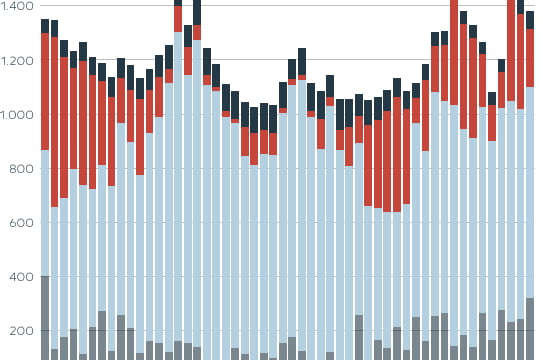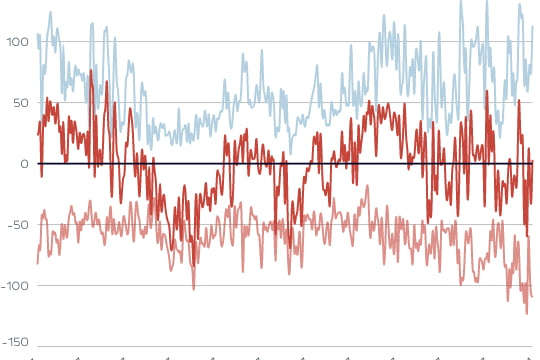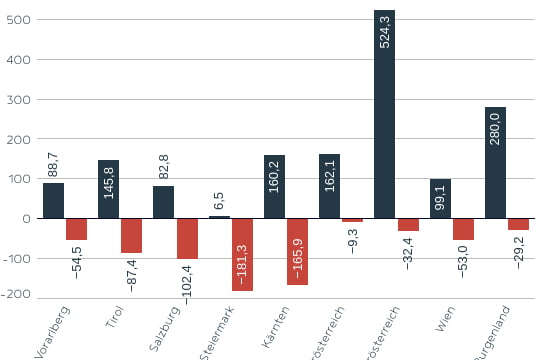Normally, electricity production from renewables, especially hydropower, falls sharply in the winter months. However, the first weeks of 2024 (calendar weeks 1 - 4) were characterized by high levels of precipitation and periods of warm temperatures throughout Austria. This resulted in an exceptionally high production from hydropower, which is atypical for the season. The renewables production totaled 4,419 GWh (gigawatt hours) of electricity in January, covering around 86% of Austria's electricity demand (5,130 GWh). While, hydropower alone contributed 3,124 GWh, which is around 71% of the renewable production, the share of wind power was around 24% or 1,068 GWh.
Due to the change in climate, the rising temperatures and the increase in precipitation in the form of rain in the winter months, hydropower is becoming increasingly important during this period. Compared to January 2023, hydropower was able to produce around 52 percent more electricity. Wind power production also increased by 42 percent compared to the previous year.
"A high-capacity electricity infrastructure, appropriate storage facilities and digital intelligence within the electricity system are necessary prerequisites to fully utilize the renewables at their planned rate of expansion in the coming years. APG's EUR 9 billion investment scheme until 2034 is therefore crucial for achieving the energy transition without jeopardizing the security of supply," emphasizes Gerhard Christiner, CTO at APG.
Austria electricity exporting country in January for the first time in over 20 years
The exceptionally good electricity generation from renewables ensured that Austria was able to export electricity abroad on 20 days in January (on the balance sheet). Usually Austria is heavily dependent on imports in January, as the low temperatures combined with precipitation in the form of snow limit production from hydropower in normal years.
"On balance, Austria was able to export 310 GWh of electricity. Good renewable production made it possible for Austria to become an exporting country again in January for the first time in over 20 years. Before that, 2003 was the last January in which Austria recorded more exports than imports," explains Christiner.
Need for redispatch measures highlights existing deficits
A strong grid is necessary to make the volatile, renewable electricity available and to transport the electricity to where it is needed. To avoid grid overloads and ensure a secure supply, the electricity flow is managed with so-called redispatch measures, i.e. the targeted and controlled use of thermal and hydraulic power plants.
“In January 2024 such interventions were necessary on 15 days. This roughly corresponds to the average monthly need for redispatching in 2023. Since also gas-fired power plants have to be used in this context, both the cost for the electricity customers and CO2 emissions increase,” explains Thomas Karall, CFO at APG.
Only a strong grid with sufficient capacities can reduce the systemic costs and CO2 emissions while improving the security of supply and facilitating the integration of all renewable plants and all players in the electricity system of the future. Therefore the immediate expansion of the grid infrastructure has the highest priority.
Energy exchange within Austria
The trans-regional electricity grid of APG also enables the exchange of energy within the country. Electricity surpluses in individual provinces can thus be distributed throughout Austria to compensate deficits.
In January, the ‘wind-strongholds’ Lower Austria (524 GWh) and Burgenland (280 GWh) were able to generate the highest energy surplus and make it available throughout Austria via the APG grid. This highlights the importance of a strong trans-regional electricity grid, as regional consumption in Lower Austria and Burgenland is very low due to low industrial production, while in Styria, for example, the situation is just the opposite: at 181 GWh, the traditional industrial province had to draw the most electricity from the APG grid, alongside Carinthia (166 GWh).
Responsible energy consumption
In January (calendar weeks 1 - 4), 5,130 GWh of electricity were consumed from the public grid in Austria - this roughly equals the consumption in January 2023 (5,124 GWh).
It is important to act responsibly when it comes to electricity consumption. Saving electricity reduces CO2 and overall systemic costs which is a significant contribution to increasing system security. The trend of reducing CO2 has to be pushed further. This also includes electricity from private PV units to cover the consumption of households.
In 2023 alone around 2,400 MW new capacity from PV systems were connected to the system in Austria. This is a very positive trend which, however, also generates new operational challenges: the increased production from private PV systems causes massive back-feeding of regional electricity surpluses from the distribution grids into APG’s transmission grid. At the same time the coverage of the electricity demand by these private systems results in a loss of data transparency regarding local consumption due to the insufficient degree of digitalization. The usual consumption peak at noon does no longer occur on sunny days: on the contrary, the flow of electricity is completely reversed and the regional electricity surpluses have to be transported elsewhere via the transmission grid. This also significantly changes the electricity price curve and even leads to negative market prices on weekends with low demand.
Due to the lack of data transparency regarding local consumption, the current electricity consumption data for Austria do not really depict the actual situation. Austria's actual electricity consumption can only be determined once all parts of the electricity system have been digitalized transparently. This means that in January 2024 certainly more electricity was consumed than in January 2023. However, the exact figures based on local and regional data are not available yet.
Tips for saving electricity can be found at www.apg.at/stromspartipps. With the APG Powermonitor, it is possible for the Austrian population to see the most effective electricity saving hours and thus make an active contribution to CO2 reduction and system security. The APG Powermonitor can be found at: www.apg.at/powermonitor.
APG continually keeps track of the development of the domestic electricity industry and regularly publishes diagrams at https://www.apg.at/infografiken regarding the topics: energy exchange, energy consumption in Austria, renewables production, import/export, electricity prices, etc.
Click here for the current infographics
About Austrian Power Grid (APG)
As independent transmission system operator Austrian Power Grid (APG) is in charge of ensuring the security of electricity supply in Austria. With our high-performance and digital electricity infrastructure and the use of state-of-the-art technologies we integrate renewable energies, we are the platform for the electricity market, and we provide access to reasonably priced electricity for Austria’s consumers and thus create the basis for Austria as supply-secure and future-oriented industrial and business location and place to live. The APG grid totals a length of about 3,400 km and is operated, maintained and continuously adapted to the increasing challenges of the electrification of businesses, industry and society by a team of approximately 850 specialists. 67 substations are distributed all over Austria and the majority is operated remotely from APG’s control center in Vienna’s 10th district. Thanks to our committed employees Austria had a security of supply of 99.99 percent also in 2023 and thus ranks among the top countries worldwide. Our investments of 445 million euros in 2024 (2023: 490 million euros, 2022: 370 million euros) are a motor for the Austrian economy and a crucial factor in reaching Austria’s climate and energy targets. Until 2034 APG will invest a total of approximately 9 billion euros in grid expansion and renovation projects.
Press contact
Christoph Schuh



